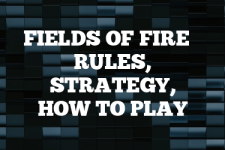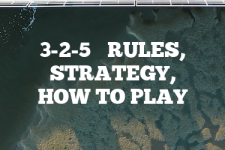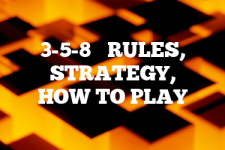Exploring the Card Game of Horseshoe – Rules, Strategies, Instructions & Winning Tips
Introduction
As a card game enthusiast, I’ve always been fascinated by the variety and complexity of games that can be played with a simple deck of cards and all the strategy that goes into that (if you’ve read many of my other guides on this site, you know I love a bit of sneaky strategy). One game like that is Horseshoe. This game, despite its simplicity, offers a unique blend of strategy and luck that can keep players engaged for hours. The game of Horseshoe is played with a standard 52-card deck and can be enjoyed by two to five players.

The origins of Horseshoe are somewhat unclear, with some sources suggesting it was first played in the late 19th century. It definitely has an place in popular culture, with the infamous (and one of my favorite gameplayers in history) Alvin ‘Titanic Thompson’ Thomas (1893-1974) being a prominent player. Regardless of its origins, the game has endured and continues to be enjoyed by card game enthusiasts around the world.
Quick Tip for Horseshoe
Remember, in Horseshoe, the goal is not just to win tricks but to accurately predict how many tricks you will win. Overbidding can be just as detrimental as underbidding, so make your bids wisely!
Rules for Playing Horseshoe
The rules of Horseshoe are relatively straightforward. The game is played in a series of rounds, with each round consisting of a deal, a bidding phase, and a trick-taking phase. The player who accurately predicts the number of tricks they will win and then successfully wins that number of tricks scores points. The game continues until a player reaches a predetermined score, typically 500 points.
While these are the official rules, many players enjoy adding their own ‘house rules’ to add variety and complexity to the game. For example, some players might introduce a rule where the dealer must bid at least one trick, or a rule where a player who fails to meet their bid loses points.
The Deal for Horseshoe
In Horseshoe, the dealer shuffles the deck and deals a set number of cards to each player. The number of cards dealt depends on the number of players: two players receive 9 cards each, three players receive 6 cards each, four players receive 4 cards each, and five players receive 3 cards each. The remaining cards are placed face down in the middle of the table to form the stock.
How to Play Horseshoe
Setup
- Choose a dealer. The dealer shuffles the deck and deals the appropriate number of cards to each player.
- The player to the left of the dealer begins the bidding phase.
Gameplay
- During the bidding phase, starting with the player to the left of the dealer and moving clockwise, each player makes a bid. The bid is a prediction of how many tricks the player believes they will win during the trick-taking phase.
- Once all players have made their bids, the trick-taking phase begins. The player to the left of the dealer leads the first trick by playing a card face up on the table. The other players, in clockwise order, then play a card of the same suit if they have one. If they do not have a card of the same suit, they can play any card.
- The player who played the highest card of the suit that was led wins the trick and leads the next trick.
End of the Game and Scoring
- The round ends after all tricks have been played. Players score points equal to the number of tricks they won, but only if they met their bid. If a player did not meet their bid, they score no points for that round.
- The game continues with the next dealer until a player reaches the predetermined score.
How to Win at Horseshoe
Winning at Horseshoe requires a combination of skill, strategy, and a little bit of luck. Here are some tips to help you improve your game:
- Pay attention to the bids of the other players. This can give you valuable information about their hands.
- Try to remember which cards have been played. This can help you make more accurate bids and make better decisions during the trick-taking phase.
- Don’t be afraid to make a low bid if you have a weak hand. It’s better to make a low bid and meet it than to make a high bid and fail to meet it.
Best Strategies for Playing Horseshoe
While there is no surefire way to win at Horseshoe, there are strategies that can increase your chances of success. Here are some strategies to consider:
- Try to control the number of tricks you win. If you’ve already met your bid, it might be in your best interest to try to lose the remaining tricks to prevent other players from meeting their bids.
- Consider the risk versus reward of making a high bid. A high bid can result in a high score, but it also carries a greater risk of not meeting your bid and scoring no points.
- Use your knowledge of the other players’ tendencies to your advantage. If a player tends to overbid, for example, you might be able to win more tricks than you otherwise would by playing your high cards early.
Game Variants
There are several variations of Horseshoe that can add variety and challenge to the game. Here are a few examples:
- In some variations, the dealer is allowed to look at the stock before making their bid.
- In other variations, a player who fails to meet their bid loses points equal to their bid.
- Some players prefer to play with a “no trump” rule, where there is no trump suit and the highest card of the suit that was led wins the trick.
Scenarios
There are countless scenarios that can arise in a game of Horseshoe, and how you handle these scenarios can greatly affect your chances of winning. Here are a few common scenarios and some strategies for handling them:
- If you have a strong hand with several high cards, you might be tempted to make a high bid. However, remember that the other players will be trying to prevent you from meeting your bid. Consider making a slightly lower bid to increase your chances of success.
- If you have a weak hand with few high cards, consider making a low bid. You might not win many tricks, but you’ll have a good chance of meeting your bid and scoring points.
- If you’re the last player to bid and the other players have already made high bids, consider making a low bid. This will give you a good chance of meeting your bid, and the other players might not be able to meet their high bids.
Frequently Asked Questions about Playing Horseshoe
What happens if two players play cards of the same rank? In Horseshoe, if two players play cards of the same rank, the first card played wins the trick.
Can I change my bid after I’ve made it? No, once you’ve made your bid, you cannot change it.
What happens if no one meets their bid? If no one meets their bid, no one scores points for that round.
Can I play Horseshoe with more than five players? While Horseshoe is typically played with two to five players, you can play with more players if you use more than one deck of cards.
What is the best strategy for winning at Horseshoe? There is no one-size-fits-all strategy for winning at Horseshoe. The best strategy depends on your hand, the bids of the other players, and the cards that have been played.
External Links
For more information about Horseshoe, visit the official Horseshoe Card Game Association website.

Eve Brownlee was a gamer before gaming communities on the internet were a thing. Eve grew up playing traditional, standard deck card games like Rummy and Bezique, taking an interest in the classics Backgammon and Chess. Parlor card games like Bridge continue to keep Eve active in the community. After a long career, primarily in horticulture for USDA in Maryland, Eve now travels and writes on The Pineapple (pineapples.info) and contributes to Quora/Pinterest topics. Contact Eve via email.



